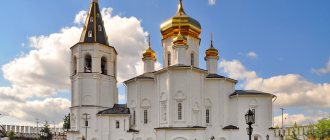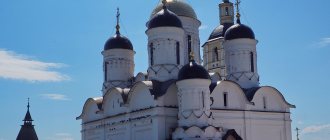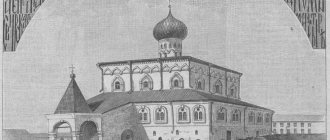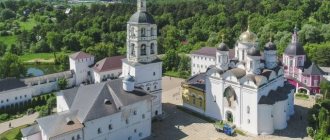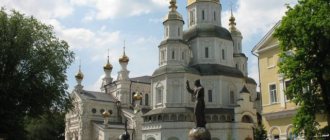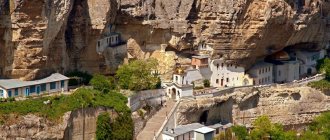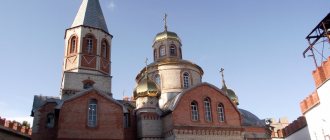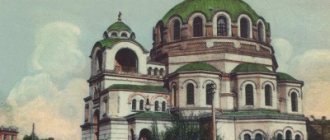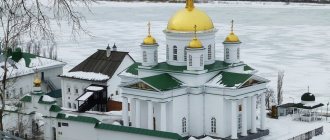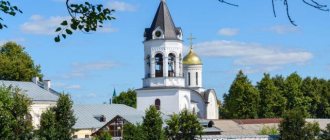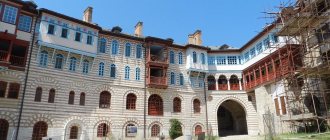Other meanings of this word:
- The names of some large Orthodox monasteries
- Alexandro-Nevskaya…
- Alexandro-Nevskaya in St. Petersburg or Troitsko-Sergiev in the Moscow region
- AlexandroNevskaya…
- Anagram for the word "emergency"
- Large Orthodox monastery
- In Kyiv it is Pecherskaya
- and. the honorary title of a famous, populous monastery, large or glorious monastic monastery; first class monastery. Supreme analysis of vat paint. Lavrsky, related to the Lavra
- And Trinity-Sergius, and Kyiv-Pecherskaya
- Kiev-Pecherskaya…
- Kiev-Pechersk monastery
- Kiev-Pechersk Monastery
- Kiev-Pecherskaya...
- Kiev-Pechersk Monastery
- Kiev-Pechora Monastery
- The largest of the monasteries
- Large monastery
- Large monastery
- Large Orthodox monastery
- Large, most important Orthodox monastery
- cool abode
- a jumble of letters from the word "emergency"
- Monastery without women, sir
- Monastery without nuns
- Monastery for monks
- the monastery is not for ladies, sir
- the monastery is not for women
- the monastery is not for the weaker sex
- Monastery in absence. nuns
- a monastery with no nuns at all
- male-only monastery
- Monastery
- Orthodox male monastery
- The name of some large privileged Orthodox monasteries under the direct jurisdiction of the Synod
- The names of some of the most important and large monasteries
- Names of some of the largest male Orthodox monasteries
- the name of some large Orthodox monasteries
- the largest and most famous monastery for its shrines
- not a nunnery
- monastery of monks
- Orthodox monastery
- Orthodox monastery
- religious - historical monastery in Russia
- religiously - historical monastery in Russia.
- Religious and historical monastery in Russia
- Trinity-Sergiev
- Trinity-Sergius...
Annunciation Monastery
Temples of the monastery
Cathedral in honor of the Annunciation of the Blessed Virgin Mary Temple in honor of the Dormition of the Blessed Virgin Mary with a monastery refectory Temple in the name of St. Alexis, Metropolitan of Moscow Temple in the name of St. Sergius of Radonezh Church in the name of the Apostle Andrew the First-Called
Shrines
Icon of the Mother of God “Korsun” of modern writing. Particles of the relics of some saints in the reliquary. An icon with a particle of the relics of St. Sergius of Radonezh, painted with the blessing of His Holiness Patriarch Kirill especially for the Sergius Church of the monastery, consecrated at the shrine with the relics of St. Sergius.
Monastery hermitage
The monastery has a monastery of the Mother of God in honor of the “Inexhaustible Chalice” icon near the village of Rozhnovo, Borsky district. The monastery has existed since 2000. It is located in the forest, about a kilometer from the Bor-Makaryevo highway, and occupies a large territory. In 2003, a temple was built on the territory of the monastery in honor of the icon of the Mother of God “The Inexhaustible Chalice”, and from that time the spiritual life of the monastery began.
Story
The Nizhny Novgorod Annunciation Monastery is located on the high right bank of the Oka River, not far from its confluence with the Volga, and currently represents a majestic monastic ensemble of white stone churches. It is believed that it was founded in 1221 by the Holy Blessed Grand Duke George Vsevolodovich and St. Simon, Bishop of Vladimir during the founding of Nizhny Novgorod.
In 1229, the monastery was attacked by the Mordovian prince Purgas, was completely destroyed and burned by the pagan prince, and ceased its activities for more than a hundred years. In 1357, Nizhny Novgorod was visited by Metropolitan Alexy of Moscow, who was heading to the Golden Horde as a representative for the Russian land. After the successful completion of his visit to the Horde, the archpastor fulfilled his vow to revive the ruined monastery. Through the efforts of Metropolitan Alexy, the white-stone single-domed Church of the Annunciation was built in 1370 and consecrated in 1371 in the Nizhny Novgorod Annunciation Monastery. In the 17th century the temple was rebuilt. The main shrine of the monastery was the Korsun Icon of the Most Holy Theotokos, donated by St. Alexis to the brethren of the revived monastery. The image was of Byzantine work, brought by the Metropolitan from Moscow. During the years of Soviet power, the image was requisitioned. At present, his fate and whereabouts remain unknown.
Revived in the 14th century, the Annunciation Monastery began to grow and prosper. The Grand Dukes of Suzdal and Nizhny Novgorod granted him land holdings and supplied the inhabitants with everything they needed. Many secular and clergy donated monetary and property contributions to the establishment of this monastic monastery, becoming its patrons, defenders and benefactors.
Since the restoration of the monastery, it began to belong to the House of Metropolitans of Moscow, and with the establishment of the patriarchate in 1589, it was called the “house monastery of the Patriarchal House,” that is, stauropegial. The Russian high priests gave letters of grant to the Nizhny Novgorod Annunciation Monastery on their own behalf and asked for mercy from the monarchs for the monastery. Thus, during the reign of Archimandrites Ferapont II (1640–1649), Sergius (1651–1654) and Paphnutius (1660–1679), the Annunciation Monastery had many different benefits and advantages, enshrined in the corresponding charters. Being a kind of center for the dissemination of church culture and education, by the end of the 19th century the Annunciation Monastery had an extensive library in which handwritten and early printed books of the 16th - 19th centuries were preserved.
The number of inhabitants living in the monastery in the 18th century, until the reform of 1764, was 5060 people. In 1764, by decision of the Holy Synod, the Annunciation Monastery was transferred to the direct management of the local diocesan bishop - the Bishop of Nizhny Novgorod and Arzamas. In connection with the establishment of states, the monastery was ranked in the third class, with abbots, however, replaced for the most part by archimandrites. Many outstanding shepherds emerged from the walls of the Annunciation Monastery. In the 19th century, two outstanding saints of the Nizhny Novgorod land labored in the Annunciation Monastery - Bishop Jeremiah (Soloviev) of Nizhny Novgorod and Archbishop Macarius (Mirolyubov). In the middle of the 19th century, the most significant event in the history of the monastery was the construction of the new Alekseevskaya Church (1837) and the new stone chapel (1847) in the name of St. Alexis, Metropolitan of Moscow, patron saint of the Annunciation Monastery. After their death, Saints Jeremiah (Soloviev, 1884) and Macarius (Mirolyubov, 1894) were buried in the Alekseevsky Church.
After the October Revolution, the Nizhny Novgorod Annunciation Monastery was closed in 1919. Gradually, various civil institutions and organizations settled within its walls. The residential premises housed a school named after M. Yu. Lermontov, as well as communal apartments for workers and employees. Warehouses and other outbuildings were used by the military department, placing convoy transport in them. On the territory of the monastery, boats were built, carriages were repaired, horses were shoed, etc. Only one small church remained at the disposal of believers in the name of the Apostle Andrew the First-Called. In 1922, under the pretext of helping the hungry, the most valuable liturgical objects were confiscated from the churches of the Annunciation Monastery - gold and silver vestments from icons, altar crosses, tabernacles, vessels, censers, lamps and much more. According to archival documents, the total weight of the 135 seized items was about 136 kilograms.
In 1923, on the basis of the official conclusion of the secular authorities, the stone over-chapel in the name of St. Alexis over the holy spring was destroyed as a dilapidated structure that did not represent any special architectural value.
In 1924, at the request of the parish council of St. Andrew's Church, which at that time was headed by Archimandrite Joseph (Kamenetsky), the monastery was accepted under the protection of the local Gubernia Museum. All its buildings were classified as the first category of monuments protected by the state, but these measures could not save the monastery from ruin. In 1928, the only St. Andrew's Church operating at that time was closed, and its property was transferred to the state. From that time on, all monastic buildings were finally nationalized and church life was interrupted. The few brethren and members of the clergy were evicted and subjected to various oppressions and persecutions.
In 1948, a planetarium was located in the Alekseevsky Church, and therefore the temple was partially rebuilt.
In 1960, the monastery ensemble as an architectural monument was taken under state protection, but all its buildings remained in a dilapidated state, without repair or reconstruction. In the 70–80s of the 20th century, partial restoration of some buildings of the Annunciation Monastery began, primarily the Annunciation Cathedral, which was damaged by the 1974 hurricane. In 1987, restoration work was completed.
The revival of the Annunciation Monastery began in 1991, when the ancient monastery was returned to the Nizhny Novgorod diocese. Church life resumed within the walls of the monastery, and divine services began to be held. September 25, 1993 is considered the official opening date of the monastery.
With the beginning of the restoration of the spiritual life of the monastery, the revival of spiritual education in the Nizhny Novgorod diocese also began. With the blessing of Metropolitan Nikolai (Kutepov) of Nizhny Novgorod and Arzamas, catechist courses were initially located within the walls of the Annunciation Monastery, and then the Nizhny Novgorod Theological Men's School, which was transformed into a theological seminary in 1995. Students of the Nizhny Novgorod Theological Seminary took an active part in the revival of the monastery, who performed various obediences in the monastery. The restoration and revival of the spiritual life of the Annunciation Monastery continues to this day.
When quoting, a link (hyperlink) to the website of the Nizhny Novgorod diocese is required.
Deposition of the Robe Convent
This monastery is located in Suzdal, founded in 1207. He became famous thanks to Saint Euphrosyne. In the world, she was Princess Theodulia of Chernigov, who took monastic vows in this monastery and then became its abbess. She performed many miracles during her lifetime, as well as 2 posthumous miracles, which the monk Gregory wrote about.
In 1923, the monastery was closed, its bells were sent to be melted down, and political isolation ward guards were stationed in the buildings. Only in 1999 it was returned to the church and it was revived.
Difficult times and revival of the monastery
In 1924, Red Army soldiers came to the monastery, ordinary monks were sent to dig trenches, and the hieromonks were shot. A gym was built in the Transfiguration Cathedral. The monastery was turned into a colony for minors.
The holy relics were placed in a local history museum, but believers came there and prayed. The outraged Bolsheviks ordered the relics to be hidden in a museum storeroom.
In the 90s of the 20th century, the monastery began to be revived. Since 1994, the tradition of pilgrimage was resumed, and a Sunday school and museum were opened in the monastery. The museum was founded by Abbot Tikhon.
The museum's collections include ancient documents and books, photographs and icons, and household items.
Recommendations
- Online Etymology Dictionary
- Crowley, John (February 2013). "Madames and Masters: Blavatsky's space soap opera." Harper
. paragraph 84. - "Tibet in Louisville." Spiritual Journeys
. Laurie. Archived from the original on 2017-11-07. Retrieved 2013-02-11. - Macartney, John (12 March 2008). "Monks are under siege in monasteries as protest ends in heavy fire." Sunday Times
. - "Colonial city of Santo Domingo. Outstanding All-Purpose Value." UNESCO World Heritage Center website
. - Dunn, Marilyn. The emergence of monasticism: from the desert fathers to the early Middle Ages. Malden, Mass: Blackwell Publishers, 2000. p.29.
- “Manastirt in the village. Zlatna Livada - nay-stariyat in Europe" (in Bulgarian). LiterNet. April 30, 2004. Retrieved May 18, 2012.
- Bill Tenney-Brittian, The Hitchhiker's Guide to Evangelism
, page 134 (Chalice Press, 2008). ISBN 978-0-8272-1454-5 - "Quran, sura 57, verse 27." www.perseus.tufts.edu
. Retrieved 2017-11-02. - "Corpus of the Qur'an in Arabic - Translation." corpus.quran.com
. Retrieved 2017-11-02. - Christopher Melchert, "Origins and Early Sufism", in Lloyd Ridgeon, ed., The Cambridge Companion to Sufism
(2014), 3-23. DOI: https://doi.org/10.1017/CCO9781139087599.003 - Khanam, Dr. (06/01/2011). "The Origin and Evolution of Sufism". الإيضاح
.
22
. - Camuran Godelek "Neoplatonic roots of Sufi philosophy", 20th World Congress of Philosophy
, [1]
| Wikimedia Commons has media related to Monasteries . |
Siberia
Irkutsk Ascension-Innocent Monastery in the Irkutsk district.
The first-class communal Ascension-Innocent Monastery is located on the left bank of the river. Angara, 5-6 versts opposite the city of Irkutsk, on the main Old Siberian highway, and 2 versts from the station. "Innokentyevskaya" Siberian Railway.
The monastery was founded in 1669–72. old man Fr. Gerasim, with the assistance of various people and with the blessing of the Siberian Metropolitan Cornelius. Land and other lands to support the new monastery were allocated by letters of Tsar Alexei Mikhailovich, and then, after the destruction of the monastery by fire in 1679, by Tsars John and Peter Alekseevich.
Currently, there are four churches in the monastery: the Ascension Cathedral, in honor of the Tikhvin Icon of the Mother of God, the Assumption and Odigitrievsky. In the monastery, in addition to the churches, there are two more chapels; one of them was completed above the crypt of Archimandrite Sinesius.
The monastery has been governed since 1883 by the vicar bishop of Cyrene, and in his absence by the viceroy, the archimandrite.
Michael the Archangel Monastery
at the Irkutsk Ascension-Innocent Monastery.
The monastery is located 2 versts from its monastery, at the Siberian Railway station. "Innokentyevskaya" roads. There is one temple in it, in honor of the Cathedral of the Archangel Michael.
Kirensky Trinity
Monastery in Kirensk.
This monastery is located in the city itself, at the confluence of the Kirenga River and the Lena River. Kirensk is 1028 versts from Irkutsk.
The monastery was founded at the request of the townspeople by Hieromonk Hermogenes. Since 1886 he has been a member of the 2nd class.
There are three churches in the monastery: 1) a two-story stone one, at the top in the name of St. John the Baptist, and at the bottom in the name of the Holy Trinity, with a chapel in the name of St. Innocent of Irkutsk; 2) two-story, wooden, at the bottom in the name of St. Nicholas the Wonderworker and 3) in the name of Alexy, the man of God.
The shrine of the monastery is the locally revered Image of the Savior Not Made by Hands, brought here by the monastery builder Hermogenes from the Abaza fort, after which it was taken by the Chinese.
The brethren of the monastery are ruled by an archimandrite.
Prince Vladimir
Monastery near Irkutsk.
Three miles from the city of Irkutsk, near the Kashtak settlement, stands the secluded Prince Vladimir Monastery and the church-teachers' seminary attached to it.
In 1903, by decree of the Holy Synod, in Irkutsk, at the Prince Vladimir Church, built by the merchant Vasil Andreevich Litvintsev, according to the will of the builder, who left special capital, a male cenobitic monastery was established, which received the name Prince Vladimir. The church was built very recently, and before it there was a dense forest here. This place was completely desolate. It was the estate of the Irkutsk merchant V.A. Litvintsev, in whose soul a holy thought arose - here, on the outskirts of the city, to create an educational center with a monastery and a school. Fulfilling this intention, the late builder first erected a beautiful, large, three-aisle church, and then buildings for the school and the monastery building and a fence around the monastery, ensuring the comfortable existence of the latter, as well as the school, with interest from the untouchable capital and obliging the monastery to maintain an almshouse. This is how the Prince Vladimir Monastery arose. In 1906, the church, located on the lower floor of the Prince Vladimir Church, was consecrated; This church was built at the expense of the late sister V.A. Litvintsev in the name of the Holy Martyr. Agrippina. The upper church has three altars: the main one is in the name of St. Equal to the Apostles. book Vladimir, the right side chapel is in honor of the icon of the Most Holy Theotokos “Helper of Sinners”, and the left side is in the name of St. Andrew of Crete and the Holy Martyr. Irina. The abbot runs the monastery.
Nilova
Pustyn in the Irkutsk District.
The desert stands on the banks of the river. Irkut, 7 versts from the Turan mineral waters and in 257 c. - from the city of Irkutsk.
Founded by Archbishop Neil in 1845, this hermitage has been under the jurisdiction of the Irkutsk bishop's house since 1851.
There is only one church in the monastery - in the name of St. Neil Stolobensky.
Content
- 1 Etymology 1.1 Terms
- 3.1 Trends
- 4.1 Western Medieval Europe 4.1.1 Catholic
- 5.1 Advaita Vedanta
Hinduism
Advaita Vedanta
Hindu Matha, Vidyasankara Temple
Since the time of the Veda (from about 1700 BC), people leading a monastic lifestyle have existed in the Indian subcontinent. In what is now called Hinduism, monks existed for a long time, and with them their respective monasteries, called Matas. Important among them are the chatur-amnaya mathas founded by Adi Shankara which formed the nodal centers under whose leadership the ancient Order of Advaitin monks was reorganized under the ten names of Dashanami Sampradaya.
- Ramakrishna Math
Sri Vaishnava
Parakala Mutt - as it is today
Ramanuja ushered in a new era in the world of Hinduism, reviving its lost faith and laying a strong doctrinal foundation for the Vishishtadvaita philosophy that has existed since time immemorial. He ensured the establishment of a number of Matas of his Sri Vaishnava Creed at various important pilgrimage centers.
- Emar Matha in Puri
- Sriranga Narayana Jeeyar Mutt in Srirangam
- Tirumala Pedda Jeeangar Mutt in Tirupati
Later, other famous theologians and Sri Vaishnava religious leaders founded various important mathas such as
- Vanamamalai Mutt
- Parakala Mutt
- Ahobila Mutt
Nimbarka Vaishnava
Uhra Nimbarka Peeth Mahanta Asthal
Nimbarka Sampradaya of Nimbarkacharya is popular in North, West and East India and has several important Maths.
- Nimbarakacharya Peeth in Salemabad, Rajasthan
- Katya Baba ka Staan in Vrindavan
- Uhra Mahanta Asthal in Uhra in West Bengal
- Howrah Nimbark Ashram in Howrah
Dvaita Vedanta
The Ashta Matha (eight monasteries) of Udupi were founded by Madhvacharya (Madhva Acharya), Dvaita philosopher.
see also
- Dissolution of the monasteries
- Ecovillage
- Intentional Community
- Khanka
- Krishnapura matha
- Monasticism
- Mount Athos
- New monasticism
- Pilgrimage
- Religious order
- Rota (architecture)
- Shivalli
- Taoism
- Thomas Merton
- Vihara
- Wudangshan
- Zawiya
- List of abbeys and monasteries
- List of Buddhist temples
- List of monasteries of the Ukrainian Orthodox Church (Moscow Patriarchate)
Verkhoturye is an ancient Ural city
At the end of the 16th century, in 1598, a fort was founded on the border of the Urals and Siberia to protect the waterway up the Kama to Solikamsk and down the Tura to the Ob. The main fortress on the way to Siberia expanded and grew. In the town, which was called the “Gateway of Siberia,” a customs office was set up, so that all Siberian goods to the west went through Verkhoturye.
Gradually the town becomes not only a cultural, but also a spiritual center of the Urals. There is no such density of churches and monasteries per thousand people as in Verkhoturye, where 8.5 thousand people live, anywhere else in the Ural region.
